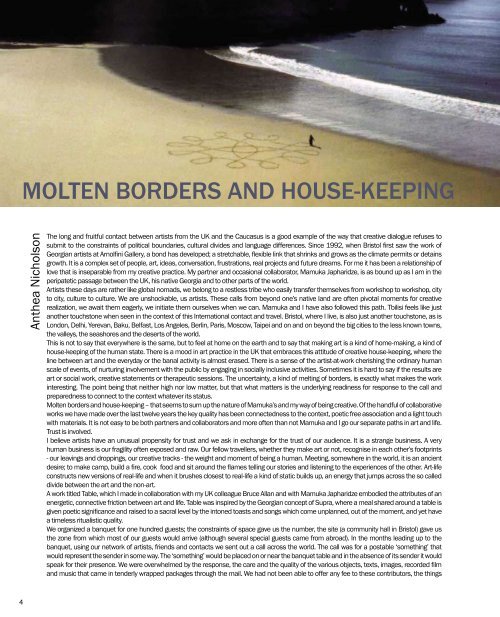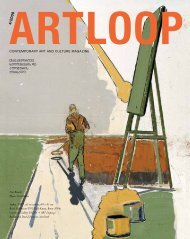xelovnebis saerTaSoriso Jurnali - Artisterium
xelovnebis saerTaSoriso Jurnali - Artisterium
xelovnebis saerTaSoriso Jurnali - Artisterium
Create successful ePaper yourself
Turn your PDF publications into a flip-book with our unique Google optimized e-Paper software.
MOLTEN BORDERS AND HOuSE-KEEPING<br />
Anthea Nicholson<br />
The long and fruitful contact between artists from the UK and the Caucasus is a good example of the way that creative dialogue refuses to<br />
submit to the constraints of political boundaries, cultural divides and language differences. Since 1992, when Bristol first saw the work of<br />
Georgian artists at Arnolfini Gallery, a bond has developed; a stretchable, flexible link that shrinks and grows as the climate permits or detains<br />
growth. It is a complex set of people, art, ideas, conversation, frustrations, real projects and future dreams. For me it has been a relationship of<br />
love that is inseparable from my creative practice. My partner and occasional collaborator, Mamuka Japharidze, is as bound up as I am in the<br />
peripatetic passage between the UK, his native Georgia and to other parts of the world.<br />
Artists these days are rather like global nomads, we belong to a restless tribe who easily transfer themselves from workshop to workshop, city<br />
to city, culture to culture. We are unshockable, us artists. These calls from beyond one’s native land are often pivotal moments for creative<br />
realization, we await them eagerly, we initiate them ourselves when we can. Mamuka and I have also followed this path. Tbilisi feels like just<br />
another touchstone when seen in the context of this International contact and travel. Bristol, where I live, is also just another touchstone, as is<br />
London, Delhi, Yerevan, Baku, Belfast, Los Angeles, Berlin, Paris, Moscow, Taipei and on and on beyond the big cities to the less known towns,<br />
the valleys, the seashores and the deserts of the world.<br />
This is not to say that everywhere is the same, but to feel at home on the earth and to say that making art is a kind of home-making, a kind of<br />
house-keeping of the human state. There is a mood in art practice in the UK that embraces this attitude of creative house-keeping, where the<br />
line between art and the everyday or the banal activity is almost erased. There is a sense of the artist-at-work cherishing the ordinary human<br />
scale of events, of nurturing involvement with the public by engaging in socially inclusive activities. Sometimes it is hard to say if the results are<br />
art or social work, creative statements or therapeutic sessions. The uncertainty, a kind of melting of borders, is exactly what makes the work<br />
interesting. The point being that neither high nor low matter, but that what matters is the underlying readiness for response to the call and<br />
preparedness to connect to the context whatever its status.<br />
Molten borders and house-keeping – that seems to sum up the nature of Mamuka’s and my way of being creative. Of the handful of collaborative<br />
works we have made over the last twelve years the key quality has been connectedness to the context, poetic free association and a light touch<br />
with materials. It is not easy to be both partners and collaborators and more often than not Mamuka and I go our separate paths in art and life.<br />
Trust is involved.<br />
I believe artists have an unusual propensity for trust and we ask in exchange for the trust of our audience. It is a strange business. A very<br />
human business is our fragility often exposed and raw. Our fellow travellers, whether they make art or not, recognise in each other’s footprints<br />
- our leavings and droppings, our creative tracks - the weight and moment of being a human. Meeting, somewhere in the world, it is an ancient<br />
desire; to make camp, build a fire, cook food and sit around the flames telling our stories and listening to the experiences of the other. Art-life<br />
constructs new versions of real-life and when it brushes closest to real-life a kind of static builds up, an energy that jumps across the so called<br />
divide between the art and the non-art.<br />
A work titled Table, which I made in collaboration with my UK colleague Bruce Allan and with Mamuka Japharidze embodied the attributes of an<br />
energetic, connective friction between art and life. Table was inspired by the Georgian concept of Supra, where a meal shared around a table is<br />
given poetic significance and raised to a sacral level by the intoned toasts and songs which come unplanned, out of the moment, and yet have<br />
a timeless ritualistic quality.<br />
We organized a banquet for one hundred guests; the constraints of space gave us the number, the site (a community hall in Bristol) gave us<br />
the zone from which most of our guests would arrive (although several special guests came from abroad). In the months leading up to the<br />
banquet, using our network of artists, friends and contacts we sent out a call across the world. The call was for a postable ‘something’ that<br />
would represent the sender in some way. The ‘something’ would be placed on or near the banquet table and in the absence of its sender it would<br />
speak for their presence. We were overwhelmed by the response, the care and the quality of the various objects, texts, images, recorded film<br />
and music that came in tenderly wrapped packages through the mail. We had not been able to offer any fee to these contributors, the things



